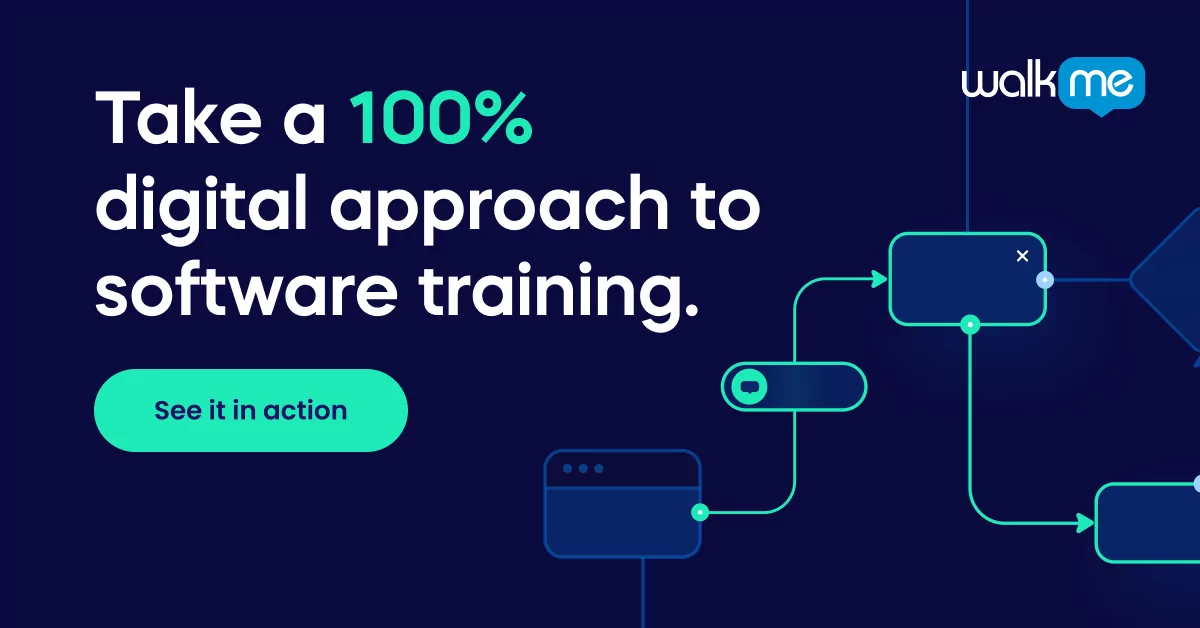The employee journey is a crucial part of any organization’s success.
Businesses fail to realize that every interaction between employees and their employers, from recruitment to retirement, is a journey. Employee experience is the sum of these exchanges, and when managed well, it can be a powerful tool for business success.
The employee journey encompasses more than just recruitment and onboarding. It also includes their career progression, such as training and development opportunities, interactions with colleagues and management, response to feedback and performance reviews, and even their experience when their employment ends.
According to a recent Gallup poll, 48% of employed Americans are seeking a new job or potential opportunities. These alarming statistics demonstrate that businesses must pay close attention to the employee journey to keep their best talent.
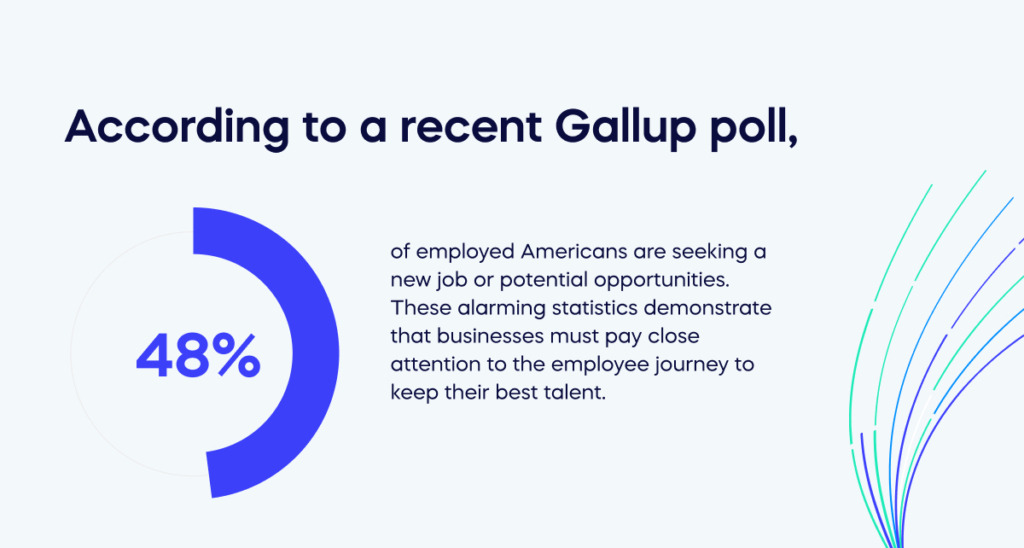
The key to successfully mapping out an employee journey is to create a culture of engagement while steadily investing in employee experience. This involves creating a personalized experience for each employee centered around their career goals.
This article will discuss the importance of the employee journey, provide tips to create effective employee experiences and highlight the most popular methods for mapping out an ideal journey. By understanding the employee journey and creating a practical experience, businesses can hold onto top talent and increase employee engagement tenfold.
What is the employee journey?
The employee journey is the collection of experiences an employee has throughout their entire tenure with a company. It encompasses everything from recruitment to employee onboarding, training, career development, and eventual departure from the company.
Essentially, it’s the story of an employee’s time with your business. Each step in this journey shapes the employee’s perspective, attitude, and motivation toward their job, company culture, and colleagues.
A negative recruitment experience may make a candidate feel undervalued and unappreciated, resulting in a lack of interest in joining your team. Similarly, poor onboarding or training failures could leave your employees feeling unsupported and unprepared for their roles, leading to low morale and reduced productivity.
Providing a positive employee journey can lead to a more engaged, productive, and loyal workforce. Creating a supportive culture prioritizes employee well-being and growth can foster a sense of community and belonging, leading to better employee retention rates, improved performance, and a strong employer brand.
What is employee journey mapping?
Customer journey mapping visually represents the customer journey, from the first point of contact to post-purchase support. It involves identifying the different touchpoints a customer interacts with throughout their journey and analyzing their feelings at each stage.
On the other hand, a customer journey is the actual experience that a customer has with a brand, including their emotional and practical interactions. While the two concepts are closely related, customer journey mapping is a tool used to gain insights into the customer journey, whereas the customer journey itself is the experience that the customer has with the brand.
Why is employee journey mapping important?
Employee journey mapping is essential for organizations that seek to gain a deeper understanding of their employees’ perspectives and experiences throughout their tenure with the company. It enables businesses to identify pain points and opportunities for improvement, which can significantly impact employee satisfaction and engagement.
By mapping out the various touchpoints along the employee journey, organizations can take a more proactive approach to improve the recruitment process, onboarding, training and development, workplace culture, communication, employee benefits, and other areas. This can help to attract and retain top talent, improve employee productivity, and positively influence overall business performance.
In today’s competitive job market, businesses must create a positive and engaging work environment that aligns with their values and goals. Employee journey mapping gives organizations the insights to establish an environment and foster a more productive, motivated, and loyal workforce.
The benefits of employee journey mapping are clear, and businesses must invest the time and resources necessary to implement this tool successfully. Doing so can create a substantial competitive advantage and contribute significantly to the organization’s long-term success.
What are the benefits of employee journey mapping?
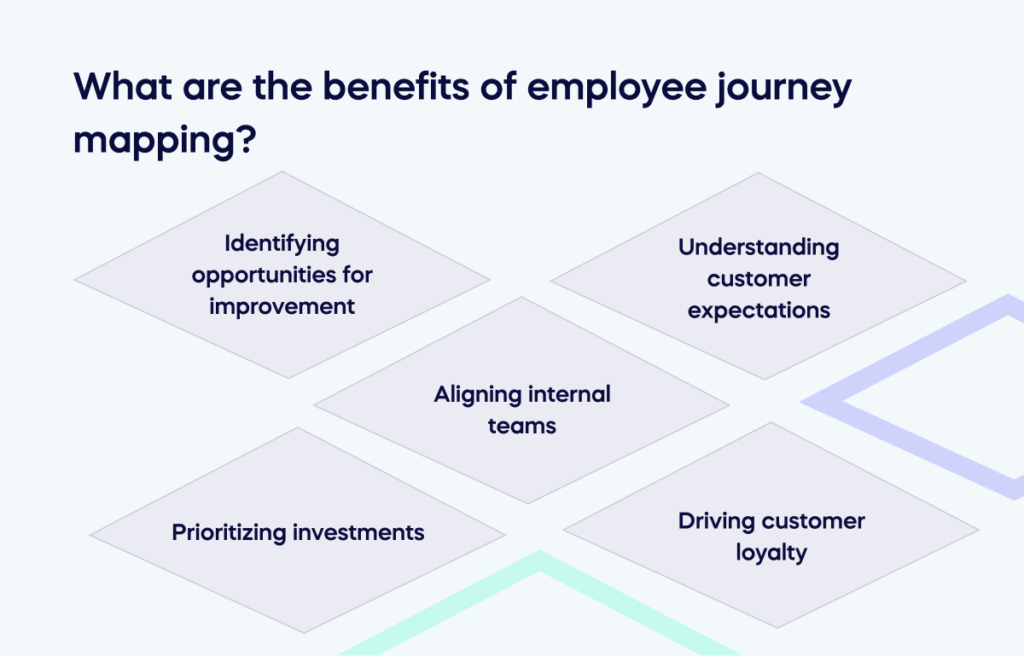
Customer journey mapping is essential for businesses looking to improve their customer experience. By visually representing each touchpoint a customer has with your brand, journey mapping can help you understand your customers’ needs, wants, and pain points.
Here are just a few benefits of customer journey mapping:
Identifying opportunities for improvement: By mapping out all of the touchpoints along the customer journey, you can identify areas where your customers may be experiencing frustration or confusion. This can help you pinpoint where to focus your efforts to improve the customer experience.
Understanding customer expectations: Journey mapping can help you better understand your customer’s expectations at each journey stage. This insight can inform everything from your marketing messaging to your product development roadmap.
Aligning internal teams: By creating a shared understanding of the customer journey across departments, journey mapping can help align your entire organization around a common goal: improving the customer experience.
Prioritizing investments: Journey mapping can help you prioritize where to invest resources to improve the customer experience. For example, if you identify customers experiencing frustration during checkout, you may invest in streamlining that process.
Driving customer loyalty: By improving the customer experience at every touchpoint, you can make loyal customers more likely to return and recommend your brand to others.
How to create an employee journey map
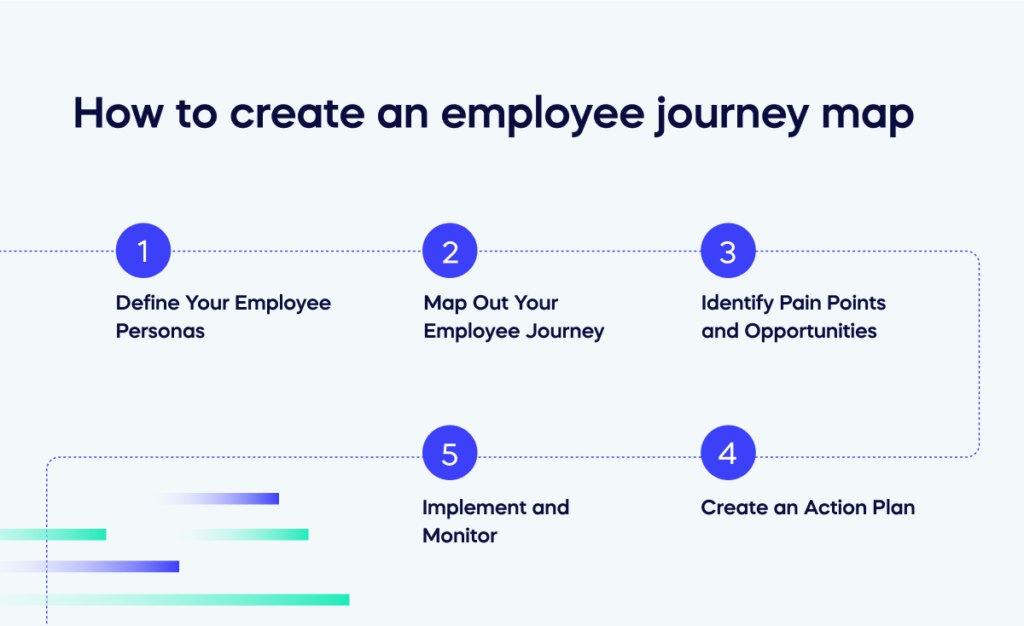
An employee journey map visually represents employees’ steps when engaging with your organization.
It helps you to evaluate the employee experience from their perspective, identify pain points and opportunities for improvement, and ultimately create a more engaging and satisfying work environment.
McorpCX reported that using an employee journey map resulted in a 25.3% increase in year-over-year employee engagement compared to the 10.8% increase for organizations that did not use journey maps.
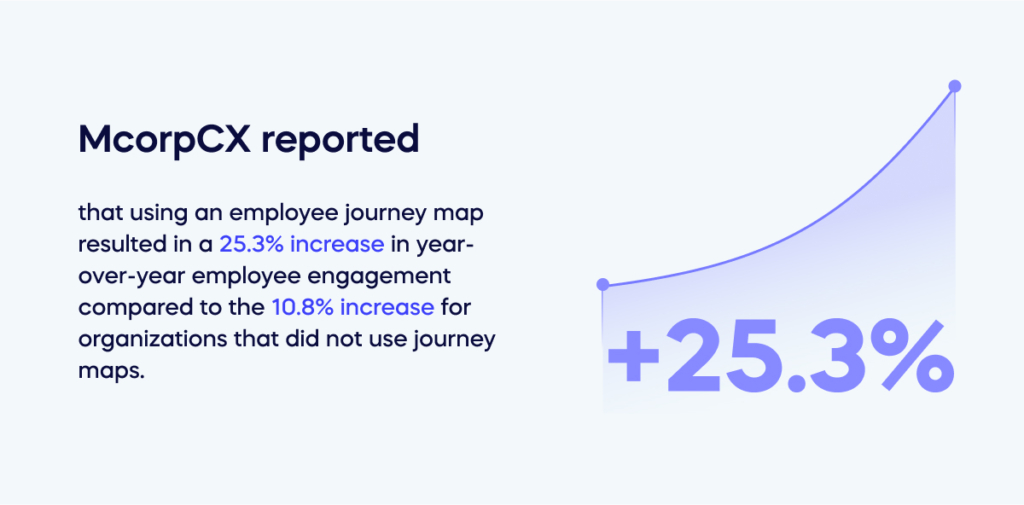
Here’s a step-by-step guide to creating and implementing an employee journey map:
Step 1: Define Your Employee Personas
Before creating an employee journey map, you must define your employee personas. An employee persona is a fictional representation of your ideal employee based on demographic, behavioral, and psychographic data.
To create your employee personas, start by conducting employee research and analyzing your existing employee data. Once you understand your employee base, you can create an employee persona document including age, gender, job title, interests, pain points, and goals.
Step 2: Map Out Your Employee Journey
The next step is to map out your employee journey. This involves identifying all an employee’s touchpoints with your organization, from initial hiring to post-employment opportunities.
To do this, gather a cross-functional team, including representatives from HR, leadership, and other relevant departments. Brainstorm all potential touchpoints an employee might have with your organization and organize them into a chronological journey.
Step 3: Identify Pain Points and Opportunities
With your employee journey map in hand, it’s time to analyze the data and identify pain points and opportunities for improvement. This involves looking at each touchpoint and evaluating it from the employee’s perspective. Ask questions such as:
- What emotions are employees feeling at this touchpoint?
- Are there any barriers or obstacles preventing employees from moving to the next touchpoint?
- How can we make this touchpoint more engaging and satisfying for employees?
As you identify pain points and opportunities, document them on your employee journey map.
Step 4: Create an Action Plan
Now that you have identified pain points and opportunities, creating an action plan to improve the employee experience is time. This involves prioritizing the most critical pain points and identifying specific actions that can be taken to address them.
For example, if you have identified that employees are experiencing frustration during the onboarding process, you may want to simplify the paperwork, provide more transparent communication about company culture and values, or offer mentorship programs for new hires.
Step 5: Implement and Monitor
Finally, it’s time to implement your action plan and monitor the results. This involves working with cross-functional teams and leadership to make the necessary changes and tracking metrics such as employee satisfaction, retention rates, and productivity.
Continue to iterate and improve your employee journey map over time, using employee feedback and data to guide your decision-making.
Creating an employee journey map is a powerful tool for gaining an in-depth understanding of your employees and improving their overall experience with your organization. By following these five steps, you can create a comprehensive employee journey map and use it to drive engagement and satisfaction within your workforce.
What comes after an employee journey map?
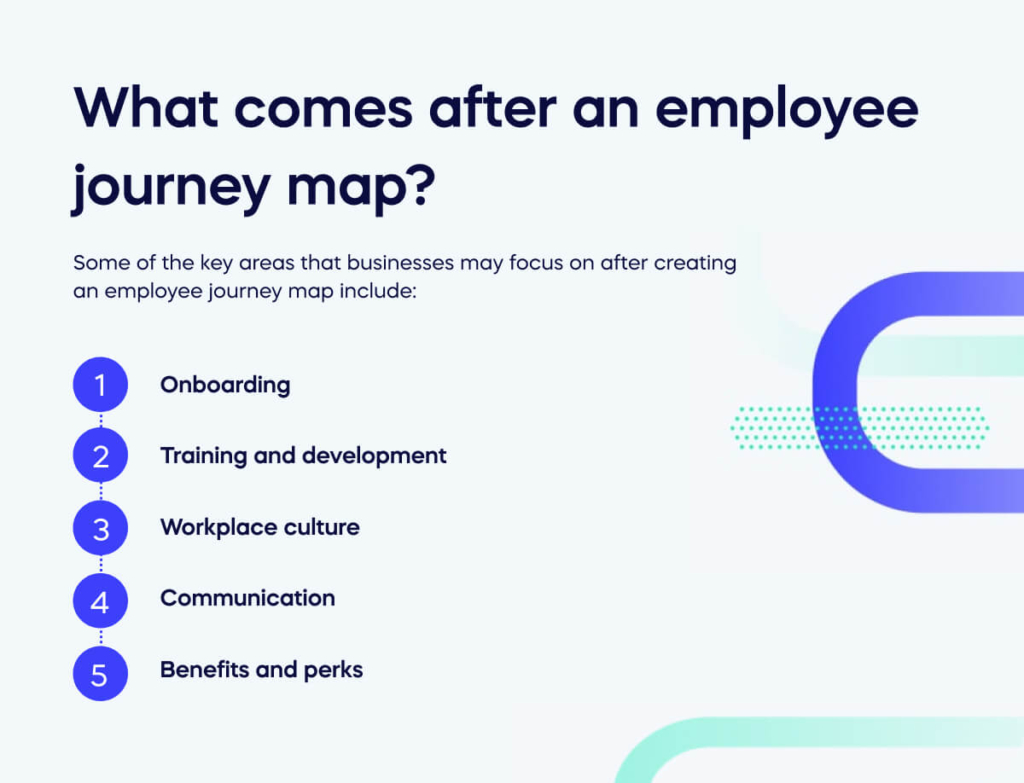
After creating an employee journey map, the next step is to take action based on the insights gained from the mapping process. This involves identifying specific pain points and opportunities for improvement and developing a plan to address them.
Some of the key areas that businesses may focus on after creating an employee journey map include:
- Onboarding: Improving the onboarding process to help new employees feel more engaged, connected, and productive from day one.
- Training and development: Providing ongoing training and development opportunities to help employees grow and advance in their roles and careers.
- Workplace culture: Fostering a positive workplace culture that aligns with the values and goals of the organization and creates a sense of belonging for employees.
- Communication: Enhancing communication channels between employees and management to ensure clarity, transparency, and engagement.
- Benefits and perks: Offering competitive compensation and perks to attract and retain top talent.
Taking action based on the insights gained from an employee journey map allows organizations to humanize their data and boost employee engagement, ultimately leading to increased productivity, retention, and overall business success.
